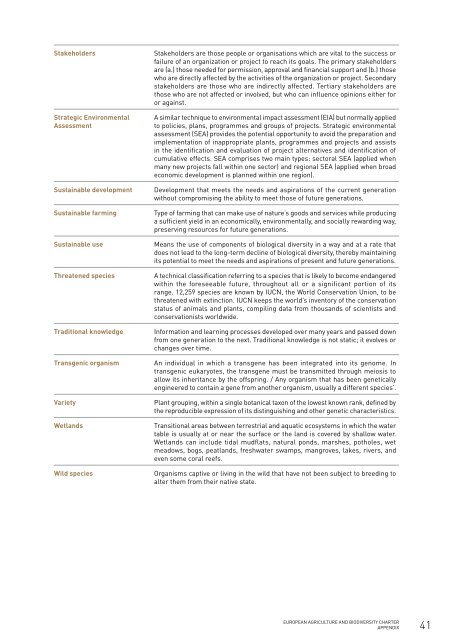agriculture - Reverse, European Project to Preserve Biodiversity
agriculture - Reverse, European Project to Preserve Biodiversity
agriculture - Reverse, European Project to Preserve Biodiversity
You also want an ePaper? Increase the reach of your titles
YUMPU automatically turns print PDFs into web optimized ePapers that Google loves.
Stakeholders Stakeholders are those people or organisations which are vital <strong>to</strong> the success or<br />
failure of an organization or project <strong>to</strong> reach its goals. The primary stakeholders<br />
are (a.) those needed for permission, approval and financial support and (b.) those<br />
who are directly affected by the activities of the organization or project. Secondary<br />
stakeholders are those who are indirectly affected. Tertiary stakeholders are<br />
those who are not affected or involved, but who can influence opinions either for<br />
or against.<br />
Strategic Environmental<br />
Assessment<br />
A similar technique <strong>to</strong> environmental impact assessment (EIA) but normally applied<br />
<strong>to</strong> policies, plans, programmes and groups of projects. Strategic environmental<br />
assessment (SEA) provides the potential opportunity <strong>to</strong> avoid the preparation and<br />
implementation of inappropriate plants, programmes and projects and assists<br />
in the identification and evaluation of project alternatives and identification of<br />
cumulative effects. SEA comprises two main types: sec<strong>to</strong>ral SEA (applied when<br />
many new projects fall within one sec<strong>to</strong>r) and regional SEA (applied when broad<br />
economic development is planned within one region).<br />
Sustainable development Development that meets the needs and aspirations of the current generation<br />
without compromising the ability <strong>to</strong> meet those of future generations.<br />
Sustainable farming Type of farming that can make use of nature’s goods and services while producing<br />
a sufficient yield in an economically, environmentally, and socially rewarding way,<br />
preserving resources for future generations.<br />
Sustainable use Means the use of components of biological diversity in a way and at a rate that<br />
does not lead <strong>to</strong> the long-term decline of biological diversity, thereby maintaining<br />
its potential <strong>to</strong> meet the needs and aspirations of present and future generations.<br />
Threatened species A technical classification referring <strong>to</strong> a species that is likely <strong>to</strong> become endangered<br />
within the foreseeable future, throughout all or a significant portion of its<br />
range. 12,259 species are known by IUCN, the World Conservation Union, <strong>to</strong> be<br />
threatened with extinction. IUCN keeps the world’s inven<strong>to</strong>ry of the conservation<br />
status of animals and plants, compiling data from thousands of scientists and<br />
conservationists worldwide.<br />
Traditional knowledge Information and learning processes developed over many years and passed down<br />
from one generation <strong>to</strong> the next. Traditional knowledge is not static; it evolves or<br />
changes over time.<br />
Transgenic organism An individual in which a transgene has been integrated in<strong>to</strong> its genome. In<br />
transgenic eukaryotes, the transgene must be transmitted through meiosis <strong>to</strong><br />
allow its inheritance by the offspring. / Any organism that has been genetically<br />
engineered <strong>to</strong> contain a gene from another organism, usually a different species’.<br />
Variety Plant grouping, within a single botanical taxon of the lowest known rank, defined by<br />
the reproducible expression of its distinguishing and other genetic characteristics.<br />
Wetlands Transitional areas between terrestrial and aquatic ecosystems in which the water<br />
table is usually at or near the surface or the land is covered by shallow water.<br />
Wetlands can include tidal mudflats, natural ponds, marshes, potholes, wet<br />
meadows, bogs, peatlands, freshwater swamps, mangroves, lakes, rivers, and<br />
even some coral reefs.<br />
Wild species Organisms captive or living in the wild that have not been subject <strong>to</strong> breeding <strong>to</strong><br />
alter them from their native state.<br />
EUROPEAN AGRICULTURE AND BIODIVERSITY CHARTER<br />
APPENDIX<br />
41



